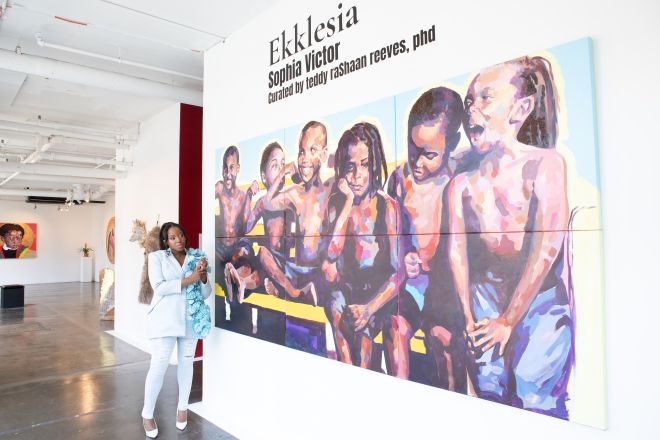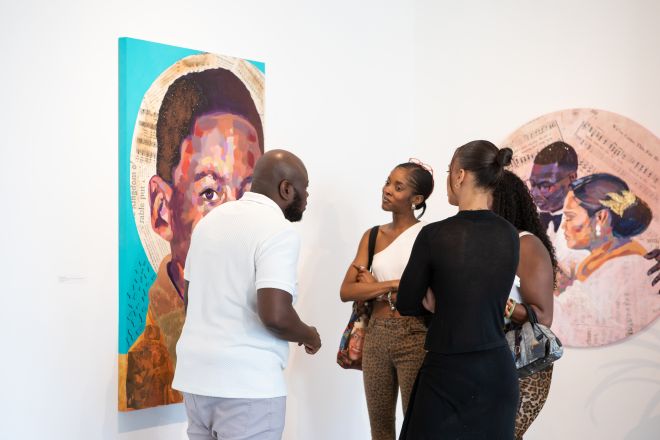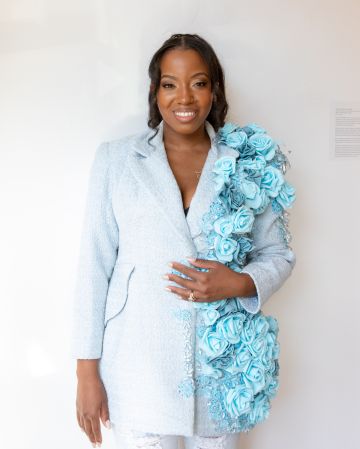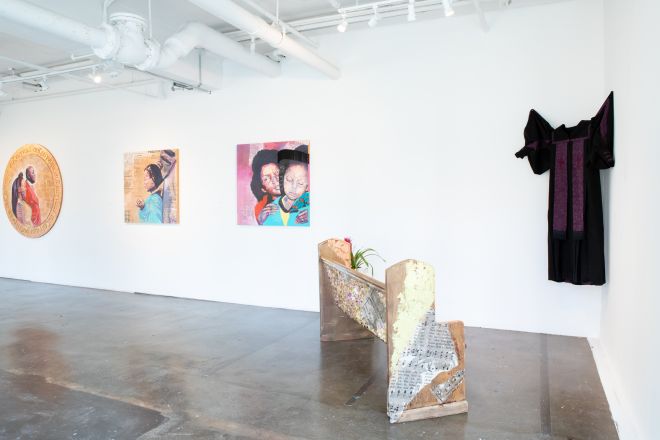Sophia Victor Transforms Black Church Traditions Into Art
Black Women, Black Faith — Sophia Victor’s ‘Ekklesia’ Honors The Spiritual Traditions That Raised Us: ‘My Art Was Always To Please God’ [Exclusive]
The Ekklesia exhibit focused on the importance of African American communal spaces.
Share the post
Share this link via
Or copy link

A graduate of both the School of Visual Arts (BFA) and New York University (MA), Sophia Victor is living out her artistic dreams. The Brooklyn-based visual artist remains in a celebratory mood, weeks after her solo exhibition Ekklesia (pronounced ek-klay-see’-ah). Sophia Victor’s Ekklesia concluded earlier this summer at The Bishop Gallery in Brooklyn. The fine art exhibit was curated by Teddy raShaan reeves, ph.d. of the Smithsonian’s National Museum of African American History and Culture. Inspired by the ancient Greek term ἐκκλησία, later adopted by early Christians, Ekklesia focused on the importance of African American communal spaces. Specifically, church gatherings and their traditions.
Equally uplifted and heartbroken by church communities over the years, Victor’s personal pursuit of finding a church home is heavily portrayed in her latest work.“Since leaving my former church, [I] spent the year as a fly on the wall at different people’s ministries,” Victor shares with MadameNoire. Victor says in that time she observed church communities, worship services, congregation conflicts, and even church departures. She adds, “…I’m the girl from Brooklyn that fell in love with the Lord, gave her life to Christ, and has been figuring it out since.” MadameNoire chatted with Sophia Victor about her recent exhibition, church, faith and beloved artwork.
RELATED CONTENT: 5 Black Female Artists Who Broke The Stained Glass Painted Ceiling

MadameNoire: “Eklessia was an exhibit that highlighted Black communal spaces and church traditions. Take us back to the opening reception.”
Love MadameNoire? Get more! Join the MadameNoire Newsletter
We care about your data. See our privacy policy.
Sophia Victor: “The opening was a big deal for me because this was my first time making work that was really personal…Church was a place where I found purpose, but this was also a place where I had moments of being taken advantage of…It’s been a journey. But God is my why. He’s the reason why I’ve been an artist for 20 plus years. He gave me a purpose with my work. He wants me to serve people through my work. This show was kind of me putting my why at the forefront.”
MadameNoire: “And there were certain things that I noticed [at the exhibit]. I’m pretty sure other people picked up on it too–those familiar with the Black church; Like the choir robe, church candy, the pew…”
Sophia Victor: “The candy was for takes [laughs]. And by the end of the show, we had refilled it like three, four, times because people were taking up that church candy. But yeah, I had talked to Teddy, the curator, about my grandmother. She passed away a few years ago, she was the Christian of my house. She was the one who was a believer out of everybody I can think of on both sides of the family. So losing her was really significant. Some of my first experiences in church was with her.
Easter Sunday every year, and her pocketbook full of peppermints. That’s literally all I can remember about anytime going to church. Even the robe, that was the curator Teddy Rashawn, [he] used to be a youth pastor… And then the bench, the pew, I wanted to do the pew from the get [go]. I didn’t really have a meaning for the pew. But then, once it was done, different people that visited the show all had their own interpretations. Some people felt like the pew was facing the robe, and the robe felt cruel and ghost-like. But then some people felt like the pew felt welcoming…When I think about my meaning for that pew, I just feel like it was a commentary on me.”

MadameNoire: “What’s it like behind the scenes, finding the right gallery to showcase your work?”
Sophia Victor: “The Bishop Gallery, I’ve been with them since 2017. When they met me, I was solely doing activist work, and they’ve kind of [helped] grow me as I’ve grown as an artist. But I know that this body of work was their hardest. [We’re] in a season and era where there’s a lot of Black spirituality in art spaces. There’s a lot of Black spirituality performance pieces. Even people that are into cultic practices, all of that is being talked about in the art world. It’s open, it’s popular, it’s trending in the art world.
[But] a lot of people have negative connotations with Christianity and religion. So my mindset is like, ‘okay, this is also where I come from, and you can’t necessarily love my work and then not want to hear about the why behind it.’ So it took a lot. It was a bit of a push concerning the gallery being open. It took some warming up for them to really be on board with the context of the work and what I wanted to say. “
MadameNoire: “It seems like you all [Teddy raShaan reeves ] have a good artist-curator relationship? Very in sync and with one accord. How did you both get connected? “
Sophia Victor: “I met Teddy at the gallery [The Bishop Gallery]. I was invited to be a part of a panel discussion and he was moderating it. I wanted to stay in touch, and we kept trying to meet back up. I gifted him a published book of letters called Correspondence, letters written to me from activists from the Black Panther movement while they were politically incarcerated over the past eight years.”
Working with Teddy as a curator was a huge blessing because I didn’t have to explain my faith. I didn’t have to explain the concept of church. I didn’t have to explain all of the complexities of it. This is someone that kind of grew up in it, right? And so the conversation could start at, ‘how do you want to do this creatively?’, as opposed to me trying to get him to understand the context of what I was coming from. And he’s also a historian, so there’s a whole bunch of stuff he brought up and told me that I didn’t know about…”

MadameNoire: “I remember at the gallery opening, you were talking about staying up all night with the canvases and trying to get things done. Can you elaborate on the creative process and making the different types of art?”
Sophia Victor: “When I started to poke around with the idea of portraits, I was like ‘well, I want to do sculpture.’ I’ve never done sculpture before. I don’t know where to start. And he [Teddy raShaan reeves] said to me, what’s the material culture of church? That was a sentence that set me down a rabbit hole. I did a brainstorm. I was like ‘the microphones, the drums, the carpet that people have been pouring oil on, the chairs that feel like carpet when you sit on them, the pews, the tambourines, the little fans.’ I went through everything I could remember.
Then every time I took a break and something else came back up, I [would] go and write it down. There was so much to play with that I feel like I only touched on a fraction of it in this show, because there was so much. And this is just memories. Then realizing that all those things are things that other people relate to too was super special. So he pushed me. He pushed me creatively. He encouraged me to do the sculpture.
We would check in every few months. A lot of it was on the phone. Every now and then, I’d send him a picture like ‘Teddy this is what I’m starting.’ When it came down to the night before the show, I think there’s two pieces that didn’t make it in the show that I really wanted. So, having to deal with butting heads and me having to humble myself and agree they’re not ready for May 17th…And I love the freedom that he gave me to keep going, like the opening is this day, but you’re an artist for forever.”

RELATED CONTENT: Tiff Massey On Her Detroit Institute Of Arts Exhibition ‘7 Mile + Livernois’, Celebrating West African And Black American Style
MadameNoire: “I wanted to touch on the opening reception once again. You had a dance ensemble and a few attendees were even crying. I believe the song was “Goodness of God.” Why did you feel the need to add the praise dance element?”
Sophia Victor: “The song was completely up to them [the dancers]. I gave them complete creative freedom. I [actually] wanted to be in it. And when I first started telling my husband, he was like ‘there’s no way you could do that for the opening’ [laughs]…And so the girls that danced were women that I used to dance with and mentored. Me literally giving them creative control was a huge deal. Me taking a step back like I’m not your [dance] leader anymore. I’m your friend. I’m your sister.”
MadameNoire: “In addition to being a visual artist, you’re also an activist, art therapist and educator. Not to mention a wife and mom. How do all these things work together in terms of stewardship?”
Sophia Victor: ”Yeah, it’s a challenge. It can be a challenge. It’s definitely not easy. It’s way too much to balance. But I’ve been telling people that there’s a lot of grace and strength that comes with it.”
RELATED CONTENT: SUNDAY NOIRE: Meet Tiffany LaTrice, The Art Activist Who Is Building An Equitable Opportunity For Black Woman Artists







